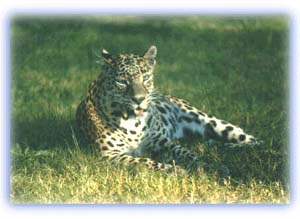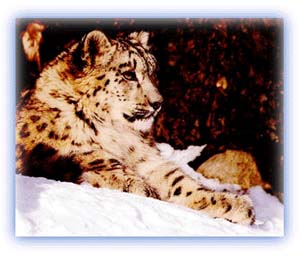Flora and fauna
General Info
· Flora
· Tropical Forests
· Temperate Forests
· Sub-alpine forests
· Alpine scrubs
· Fauna
· Mammals
· Cats
· Tiger
Snow Leopard
· Leopard Cat
· Jungle Cat
· Lynx
· Dog Family
· Bears
· Weasel Family
· Rodents
· Horse Familiy
· Yak
· Wild Yak
· Bharal
· Ibex
· Deer
· Birds
Why are these animals endangered?
How much money do the poachers make?
Protected Areas
· Nepal
· India

![]()
|
Leopard or Panther (Panthera pardus) The panther is found at relatively lower elevations in the transition zone between the main Himalaya and cold deserts. They have the capacity to survive under very difficult conditions. The leopards are not restricted to forests like other members of the cat family. Leopards may hunt during the day if nights are very cold or if food is not available at night. In the cold deserts they tend to migrate according to the seasons, moving to lower elevations in winter and ascending to higher elevations in summer. This is primarily influenced by the availability of food and climatic conditions. |
The elusive snow leopard. (Download Realplayer) |
 |
| Leopard Credit: Allen Matheson |
Due to shortage of wild food, and the growing population of livestock, leopards may take to cattle lifting in the mountainous areas.
Snow Leopard or Ounce (Panthera unica)
The elusive snow leopard has a pale grey coat on the upper
side which may be pure white on the underside. It is believed to
have been found over large parts of the cold desert regions in the past
but
in recent times its distribution has shrunk significantly. At present
the snow leopard is found in parts of Ladakh, Spiti, Garhwal, Kumaon,
and
at times migrating to other areas. Snow leopards number from 4 to 6
per 100 sq. kms in a relatively protected area where
preys are available easily.
 |
| The elusive snow leopard Credit: Rajesh Shrestha |
Information about the habits of this animal is very poor as the inaccessibility of its habitats makes observation by humans very difficult. The snow leopard may live in the grasslands and bare rocks near the snowline. They are usually nocturnal in habit, lying cleverly concealed amongst the rocks during the day and hunting at night. Their prey includes wild sheep and goats, musk deer, hares, marmots and other rodents and at times even larger birds. They are in the habit of establishing their territory quite like other members of the cat family.
The snow leopard is an altitudinal migrant, moving to the shelter of the valleys in winter and ascending to higher reaches in summer. Like other beasts of prey their movement too is governed by the migration of their main prey.
All rights reserved